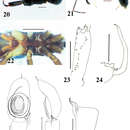Myrmarachne epigealis: Brief Summary
(
шпански; кастиљски
)
добавил wikipedia ES
Myrmarachne epigealis es una especie de arañas araneomorfas de la familia Salticidae.
- лиценца
- cc-by-sa-3.0
- авторски права
- Autores y editores de Wikipedia
Description
(
англиски
)
добавил Zookeys
(male/female). Carapace length 2.63– (2.83) / 3.20–3.35, width 1.35– (1.40) /1.33–1.48. Chelicera length 1.90– (2.07). ALE–PLE 0.95– (1.00) /1.03–1.13; ALE–PME 0.45– (0.47) / 0.50–0.55. Width of eye row I 1.28– (1.33) / 1.38–1.45; II 1.13– (1.18) /1.20–1.28; III 1.33– (1.38) / 1.43–1.53. Eye size: AME (0.43) / 0.43–0.45; ALE 0.22– (0.23) /0.22–0.23; PME 0.06– (0.08) /0.08; PLE 0.23– (0.24) / 0.25–0.26.
Male (Figs 20–27). Cephalic part weakly convex dorsally, distinctly higher than thoracic part; in lateral view, dorsum of carapace sloping downward behind PLE, and concave between cephalic and thoracic parts; lateral surface between cephalic and thoracic parts weakly incised; thoracic part roundly swollen overall (Figs 20–21). Chelicera slightly shorter than carapace; with chelicera in dorsal view, its dorsal prolateral margin diverted toward retrolateral margin in distal half, exposing prolateral surface (Fig. 20); venter of chelicera bearing four to five prolateral and eleven to 14 retrolateral teeth (Fig. 23); apical prolateral corner of venter forming large tooth-like apophysis; with chelicera in ventral view, one retrolateral tooth present next to third retrolateral tooth counted from base, and one prolateral tooth slightly proximal to row of retrolateral teeth. Fang weakly sinuous, without tooth-like apophysis (Fig. 24). Pedicel short (0.30–0.43 mm). Abdomen oval with weak constriction at anterior fourth, and its entire dorsum covered with two contiguous dorsal scuta; lateral margins strongly incised where scuta come together (Figs 20–21).
With palp in dorsal and ventral views, cymbium elongate-oval with one apical spine (Fig. 25). Tegulum oval, with long seminal reservoir along margin of tegulum (Fig. 25). Embolus forming two oval coils; more ventral embolus coil as wide as venter of cymbium, slightly narrower than basal coil (Fig. 25). RTA well developed with the tip curved inward, and without a distinct its flange (Figs 26–27).
Number of spines on legs. Patella I pv 0, rv 0–1; tibia I pv 5, rv 5; metatarsus I pv 2, rv 2; tibia II pv 3, rv 3; metatarsus II pv 2, rv 2.
Coloration in alcohol and pilosity. Carapace and chelicera black, covered with very short inconspicuous setae (Figs 20–21). Carapace with pair of light brown spots behind PLE. Endite, labium and sternum light brown, tinged with black (Fig. 22). In ventral view, coxa and trochanter I light yellow, tinged with gray on posterior margin of coxa and laterally on trochanter; coxa II black, trochanter II like trochanter I; coxa and trochanter III black, trochanter yellow ventrally strongly tinged with black; coxa IV blackish with yellow venter strongly tinged with black, trochanter IV light yellow (Fig. 22). Abdomen and its dorsal scuta black, covered with fine setae (Figs 20–21).
Female (Figs 28–32). Cephalic part very weakly convex or almost flat, higher than thoracic part; with carapace in lateral view, dorsal concavity roundly convex behind PLE; thoracic part swollen dorsally overall (Figs 28–29). Chelicera bearing seven prolateral and 13 to 14 retrolateral teeth on its venter. Pedicel short (0.43–0.55 mm). Abdomen oval with weak constriction in anterior third, and without obvious dorsal scuta (may be present under pilosity).
Epigyne (Figs 31–32). Copulatory atria containing openings round. Median pocket present in front of epigastric furrow, weakly sclerotized. Sclerotized copulatory ducts extending from oval spermathecae without twists to posterolateral to atria.
Number of spines on legs. Patella I pv 0, rv 1; tibia I pv 5, rv 5; metatarsus I pv 2, rv 2; tibia II pv 3, rv 3; metatarsus II pv 2, rv 2.
Coloration in alcohol and pilosity. Carapace mainly black, covered with white setae densely; carapace with pair of light brown spots behind PLE; lateral surface of carapace above coxa I white, densely fringed with white setae (Figs 28–29). Chelicera brown. Endite, labium and sternum brownish cream, weakly tinged with black (Fig. 30). Coxae and trochanters in ventral view similar to those of males, except coxa IV with much more yellow ventrally, and trochanter IV yellow with distal retrolateral black spot (Fig. 30). Abdomen covered with golden setae dorsally, and with fine setae ventrally (Fig. 28).
- лиценца
- cc-by-3.0
- авторски права
- Takeshi Yamasaki, G. B. Edwards
- библиографски навод
- Yamasaki T, Edwards G (2013) The genus Myrmarachne (Araneae, Salticidae) in Flores, Indonesia ZooKeys 299: 1–20
- автор
- Takeshi Yamasaki
- автор
- G. B. Edwards

